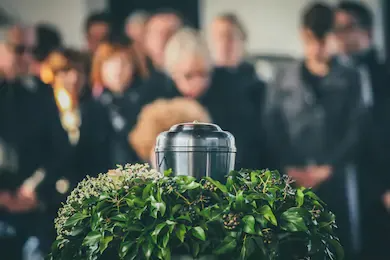Is it Necessary to Embalm a Body?
Samantha K. Smith, FD, writes on why Kuhn Funeral Homes recommends that families choose to allow their loved ones to be embalmed.

As a licensed funeral director, a large portion of my day-to-day work at Kuhn Funeral Homes, Inc., relates directly to the care of decedents entrusted to our mortuary. I am entrusted with performing the necessary procedures so that a family is able to see their loved one. My friends and family have a lot of questions about the work I do, and I am sure there are many people in the world who would love to have some questions answered about what happens in the funeral home “behind the scenes.”
One such question I am frequently asked is, “Do I really need to be embalmed?”
What does the law say about embalming?
The short answer is that embalming is not required by law (in fact, the Federal Trade Commission’s Funeral Law forbids any funeral home from stating the contrary)...
...BUT the Pennsylvania Code that dictates professional conduct for funeral directors within the Commonwealth does require that that if human remains are not embalmed within 24 hours of death, then those remains must either be sealed inside a container that does not allow fumes or odors to escape OR those remains must kept under refrigeration. If remains are kept in refrigeration until the time of a funeral, disposition of those remains must occur within 5 hours of removal from refrigeration. The Code further states that the public should not view an unembalmed body that has been kept in refrigeration for longer than 36 hours.
That’s a rather long “but.”
If a family is choosing for their loved one to be cremated without first having a public viewing, then there is no need for their loved one to be embalmed. Furthermore, the Federal Trade Commission forbids any funeral home from claiming that embalming is necessary inorder for human remains to be cremated. (The FTC also forbids a funeral home from stating that a casket is necessary for cremation, but that is a separate topic altogether.)
Some cemeteries require that human remains be embalmed by a licensed funeral director in order for those remains to be entombed in a mausoleum. This is a cemetery requirement, not a federal or state law.
When the public is invited to a funeral with an open-casket viewing proceeding the service, we at Kuhn Funeral Homes recommend that we be allowed to perform the embalming.
What is embalming?
What is embalming? Embalming is a surgical procedure by which the body’s blood volume is drained and replaced with specialized chemicals. Embalming accomplishes three goals: disinfection, preservation, and restoration. The remains are disinfected so that harmful microbes are destroyed, preserved so that the natural processes of decomposition are slowed, and restored so that an eased appearance can be returned to the person. Embalming cannot completely halt the natural process of decomposition; in fact, it is against federal law to suggest that embalming can completely stop decomposition. Embalming is one method funeral directors have to ensure that human remains are able to be interacted with by the public.
But what about refrigeration?
Some critics of embalming argue that the availability of refrigeration makes embalming completely unnecessary. They say that refrigeration can do a sufficient job controlling the rate of decomposition. The truth is a little more complicated than that. Refrigeration can slow decomposition, that is true, but human remains decompose at different rates according to different factors. A person’s weight, height, age, and medical conditions all affect how quickly sign of decomposition become noticable. For one person’s remains, it may take several days; for another person’s remains, signs of decomposition may be very noticeable just a few hours after death. Rates of decomposition aside, refrigeration does impact the way a person looks. Refrigeration causes a body’s skin to dry out and the facial features to sink and sag. These changes in appears can be startling, even rendering someone utterly unrecognizable.
Creating a Final Memory Picture
When restoring a deceased human being during the embalming procedure, the goal is to create a positive final memory picture so that the last time an individual sees the person he or she loves, he or she is not left with the memory of someone suffering sickness or trauma. Signs of trauma like wounds, scrapes, or cuts can be closed and the skin restored with a little bit of special wax and a fine coat of mortuary makeup. Signs of sickness like sunken eyes or hollow cheeks can be addressed during the embalming procedure. Bruises, whether from the trauma of a fall or the results of a hospital’s IV line, can be artfully blended away.
Brad Krick, another Funeral Director here at Kuhn Funeral Homes, recently worked with a family whose loved one had suffered tongue and throat cancer--this woman’s entire lower jaw had been removed in an effort to beat her cancer. It was very important to the family to be able to have an open-casket viewing as the deceased had been a vibrant woman with many friends and connections to the community. Brad was able to reconstruct her jaw with wax, a stippling brush, and mortuary cosmetics. Brad’s reconstruction was so accurate and detailed that mourners who came to this woman’s services were shocked when a family member mentioned in the eulogy that the deceased had been missing a significant facial feature.
For survivors who had suffered a sudden or traumatic loss, such as their loved one dying in a car crash, being a victim of violent crime, or suicide, it is common to want to see their loved one’s remains. The restoration work performed during and after the embalming enables funeral directors to restore human remains affected by trauma to a condition familiar to their loved ones. For remains that have been autopsied in order for a medical examiner or private doctor to determine the cause of death, or for remains that have undergone a long-bone or skin donation, the unembalmed body may simply be not suitable for viewing. The challenges an embalmer faces for such cases are numerous, but the work enables a family to see their loved one one last time.
Time and time again we hear from our families how helpful and healing it was to see their loved one laid peacefully for viewing with an expression of serenity. Recently, a woman testified she was so anxious about seeing her mother again. She had been present at the nursing home after her mother’s death, and the image of how her mother looked was haunting her. She said her mother’s eyes, open, blank and unfocused, were all she could think about.
We invited her to come before the day of her mother’s services so she and her brother could spend some time with their mother without distractions. Their mother had been embalmed, dressed, and laid in her casket in our funeral parlor, just as she would be for her funeral the following day. The siblings spent almost an hour with their mother. When they came out of the viewing parlor, the woman had a soft smile on her face and told us that her mother looked the way she did when she still had the energy to go have her hair done. “My mother hasn’t looked this much like herself since the chemo began,” the woman expressed.
Grief studies demonstrate over and over the important role viewing plays in accepting the reality of a loss. Elisabeth Kubler-Ross writes that denial’s purpose is to help survivors through a loss by making survivors numb to overwhelming emotions. That denial must be overcome in order for healing to progress. When a body is viewed, the death is confirmed. Being able to reach out and touch a loved one’s hands or caress a loved one’s cheek enables the survivors to demonstrate their love for the individual and confront their own feelings about the loss. Seeing is believing, and seeing the body of a loved one is an important means of breaking through the natural impulse to deny death.
The same grief studies that highlight the importance of viewing a body also address the possibility that choosing not to view a body can leave someone with feelings of regret. He or she might wonder if their loved one is really deceased or if their loved one is really the one in the casket. There is some comfort in certainty.
There are some who argue that we funeral directors place too much importance on viewing a body. They argue that it would be better to remember the good times with a loved one rather than see them dead. While I sympathize with the desire to focus on the good memories, I argue that the decision to view a deceased loved one’s body is an entirely personal choice. No one should be forced against his or her will to view the remains of a loved one . No one. Forcing someone to view human remains against his or her will can be incredibly damaging and traumatic. Each person must decide for his or her self what feels appropriate in a given situation. My professional opinion is that allowing the funeral home to perform the embalming offers the greatest chance of a family having a peaceful final image of their loved one.
In summary
Embalming is not a legal requirement according to federal law, but it is Kuhn Funeral Home’s recommendation that a family allow us to perform the embalming when planning a public, open casket viewing. Embalming best enables the funeral home to ensure the deceased’s appearance is peaceful and true to their appearance in life. As a licensed funeral director, I take great pride in the work I do to care for the bodily remains of loved ones families entrusted to the funeral home’s care.





